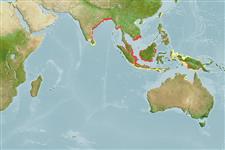>
Siluriformes (Catfishes) >
Ariidae (Sea catfishes) > Ariinae
Etymology: Arius: Greek, arios, areios = dealing with Mars, warlike, bellicose (Ref. 45335).
More on author: Hamilton.
Environment: milieu / climate zone / depth range / distribution range
Ecologia
marinhas; Água doce; estuarina demersal; anfídromo (Ref. 51243). Tropical
Indian Ocean: India and Bangladesh (Ref. 4833). Reported from the South China Sea (Ref. 39501).
Tamanho / Peso / Idade
Maturity: Lm ? range ? - ? cm
Max length : 91.4 cm SL macho/indeterminado; (Ref. 1813)
Found in estuaries and tidal rivers. Ascends rivers beyond tidal reach (Ref. 1479).
Life cycle and mating behavior
Maturidade | Reprodução | Desova | Ovos | Fecundidade | Larvas
Talwar, P.K. and A.G. Jhingran, 1991. Inland fishes of India and adjacent countries. Volume 2. A.A. Balkema, Rotterdam, i-xxii + 543-1158, 1 pl. (Ref. 4833)
Categoria na Lista Vermelha da IUCN (Ref. 130435: Version 2024-1)
Ameaça para o homem
Traumatogenic (Ref. 58010)
Utilização humana
Ferramentas
Relatórios especiais
Descarregue XML
Fontes da internet
Estimates based on models
Preferred temperature (Ref.
123201): 27.3 - 29.4, mean 28.7 °C (based on 198 cells).
Phylogenetic diversity index (Ref.
82804): PD
50 = 0.5000 [Uniqueness, from 0.5 = low to 2.0 = high].
Bayesian length-weight: a=0.00776 (0.00440 - 0.01371), b=3.06 (2.91 - 3.21), in cm total length, based on LWR estimates for this species & (Sub)family-body (Ref.
93245).
Nível Trófico (Ref.
69278): 3.7 ±0.4 se; based on size and trophs of closest relatives
Resiliência (Ref.
120179): Baixo, tempo mínimo de duplicação da população 4,5 - 14 anos (Preliminary K or Fecundity.).
Fishing Vulnerability (Ref.
59153): High to very high vulnerability (67 of 100).
